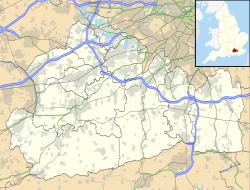History
The Norman manorial owner after the Conquest gave the churchlands and tithes payable across the privately held land (the bulk, which did not form wooded or meadowland common or unproductive waste) to the monks of the parish to Merton Priory: during the reign of Henry I (1100–1135), Gilbert the Norman, High Sheriff of Surrey, gave the advowson of Kingston - the right to appoint the incumbent priest of a church - together with four young chapelries [n 1] to Merton Priory. Whether these were fully built of stone at the point is uncertain. [1]
Gilbert died in 1125, which demonstrates a functional chapelry, whether or not of stone, at Thames Ditton around 1120, with higher levels of ecclesiastical control by Kingston Church and Merton Priory. In any event the earliest stonework of the church appears to English Heritage to date to the 12th century. [2] A certain 'William' was Vicar at Thames Ditton from 1179.
After the Dissolution of the Monasteries, the advowson and rectory of St Nicholas passed into private hands as from 1538. For previous centuries, the great tithes rested with Kingston rectory, whereas the owners of Imber Court replaced it from the 16th century until the 19th century as partial tithe beneficiaries and patrons, paying for the curate himself. By 1848, the rectory had been replaced by a perpetual curacy belonging to King's College, Cambridge. [3]
This page is based on this
Wikipedia article Text is available under the
CC BY-SA 4.0 license; additional terms may apply.
Images, videos and audio are available under their respective licenses.










